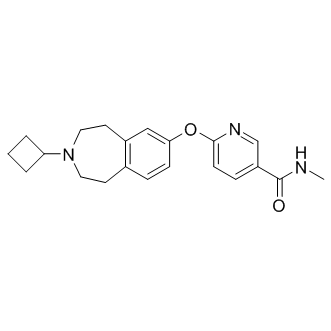| Cas No.: | 720690-73-3 |
| Chemical Name: | GSK-189254 free base |
| Synonyms: | GSK189254A,GSK-189254A,GSK 189254A |
| SMILES: | CNC(=O)C1=CN=C(C=C1)OC2=CC3=C(CCN(CC3)C4CCC4)C=C2 |
| Formula: | C21H25N3O2 |
| M.Wt: | 351.45 |
| Purity: | >98% |
| Sotrage: | 2 years -20°C Powder, 2 weeks 4°C in DMSO, 6 months -80°C in DMSO |
| Description: | GSK189254A (GSK189254) is a novel, potent and selective histamine H3 receptor antagonist with pKi values of 9.59-9.90 and 8.51-9.17 for human and rat H3, respectively. |
| Target: | pKi: 9.59-9.90 (H3, human), 8.51-9.17 (H3, rat)[1] |
| In Vivo: | GSK189254 (0.3-3 mg/kg p.o.) increases the release of acetylcholine, noradrenaline, and dopamine in the anterior cingulate cortex and acetylcholine in the dorsal hippocampus. GSK189254 significantly improves performance of rats in diverse cognition paradigms, including passive avoidance, water maze, object recognition, and attentional set shift[1]. In Ox+/+ and Ox−/− mice, acute administration of GSK189254 increases W and decreases slow wave and paradoxical sleep to a similar degree to modafinil, while it reduces narcoleptic episodes in Ox−/− mice[2]. |
| In Vitro: | GSK189254 has high affinity for both recombinant H3 receptors expressed in HEK-293-MSR-II cells and native H3 receptors expressed in the cerebral cortex of several species. GSK189254 generally exhibits higher affinity for human and pig H3 receptors compared with rat,mouse, and dog H3 receptors. [3H]GSK189254 binds in rat and human brain areas, including cortex and hippocampus. GSK189254 may have therapeutic potential for the symptomatic treatment of dementia in Alzheimer’s disease and other cognitive disorders [1]. |
| Animal Administration: | Rats: Pharmacokinetic studies with GSK189254 are conducted in conscious male Sprague-Dawley rats. Animals receives an intravenous infusion of GSK189254 (n=3) administered at a nominal dose level of 1 mg of free base/kg for 1 h via the femoral vein cannula (10 mL/h/kg). GSK189254 is dissolved in 0.9% (w/v) saline at a target concentration of 0.1 mg free base/mL and filtered with a 0.22-mm Millex-GV filter before administration. After a ish out of at least 2 days, the same rats received a single oral administration of GSK189254 by gastric gavage to achieve a target dose of 2 mg of free base/kg. GSK189254 is formulated in 1% (w/v) aqueous methylcellulose at a target concentration of 0.4 mg free base/mL[1]. Mice: The vehicle consists of 0.05 mL NaCl at 0.9% containing methylcellulose at 1%. GSK189254 is dissolved in vehicle solution. The effects of acute and repeat administration of GSK189254 on the sleep-wake cycle in wild-type (Ox+/+) and orexin knockout (Ox−/−) mice is investigated. GSK189254 (3 and 10 mg/kg, p.o.) is administered on the sleep-wake cycle in Ox+/+ and Ox−/− mice, dosed at 10 h. The oral administration dose of GSK189254 is 10 mg/kg[2]. |
| References: | [1]. Medhurst AD, et al. GSK189254, a novel H3 receptor antagonist that binds to histamine H3 receptors in Alzheimer's disease brain and improves cognitive performance in preclinical models. J Pharmacol Exp Ther. 2007 Jun;321(3):1032-45. [2]. Guo RX, et al. Differential effects of acute and repeat dosing with the H3 antagonist GSK189254 on the sleep-wake cycle and narcoleptic episodes in Ox-/- mice.Br J Pharmacol. 2009 May;157(1):104-17. |

 DC Chemicals' products qualify for U.S. tariff exemptions. We guarantee no price increases due to customs duties and maintain stable supply, continuing to deliver reliable research solutions to our American clients.
DC Chemicals' products qualify for U.S. tariff exemptions. We guarantee no price increases due to customs duties and maintain stable supply, continuing to deliver reliable research solutions to our American clients.





















